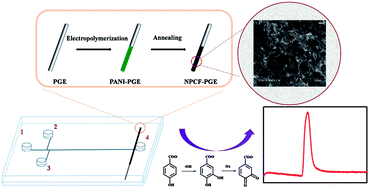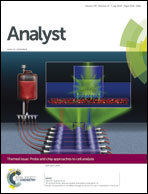A rapid and sensitive method for hydroxyl radical detection on a microfluidic chip using an N-doped porous carbon nanofiber modified pencil graphite electrode†
Abstract
Hydroxyl radicals (˙OH) play an important role in human diseases. Traditional detection methods are time consuming and require expensive instruments. Here, we present a simple and sensitive method for the detection of hydroxyl radicals on a microfluidic chip using an electrochemical technique. Aniline monomer is electrochemically polymerized on the surface of a pencil graphite electrode and carbonized at 800 °C. The resulting N-doped porous carbon nanofiber-modified pencil graphite electrode is embedded into a microfluidic chip directly as a working electrode. 4-Hydroxybenzoic acid (4-HBA) is selected as the trapping agent owing to its unique 3,4-DHBA product and high trapping efficiency. A low detection limit of 1.0 × 10−6 M is achieved on the microfluidic chip. As a demonstration, the microfluidic chip is successfully utilized for the detection of ˙OH in cigarette smoke. The strong π–π stacking and hydrophobic interactions between the nitrogen-doped carbon materials and the pencil graphite make the modified electrode well-suited for the microfluidic chip.


 Please wait while we load your content...
Please wait while we load your content...